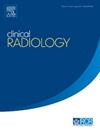The perils of Double-J stent placement: What radiologists must know
IF 2.1
3区 医学
Q2 RADIOLOGY, NUCLEAR MEDICINE & MEDICAL IMAGING
引用次数: 0
Abstract
The use of ureteral stents has seen a substantial rise in modern urological practice, serving as an indispensable tool in the management of urinary tract obstructions, stone disease, and postoperative drainage. However, their widespread application is accompanied by a high incidence of complications, each with potentially devastating consequences if left unrecognized. Encrustation and stone formation may result in obstruction, necessitating complex retrieval procedures. Stent migration can lead to severe discomfort, infection, and compromised renal function. Infection and pyelonephritis, if undetected, may progress to urosepsis, a life-threatening condition. Additionally, stent fracture and ureteral perforation can precipitate extensive morbidity, sometimes requiring surgical intervention. Given the critical nature of these complications, early detection through imaging is paramount. Radiologists play a pivotal role in diagnosing and characterizing these complications, ensuring timely management. By providing meticulous reporting of stent positioning, encrustation, migration, and associated pathologies, radiologists contribute to preventing severe adverse outcomes. A collaborative approach between urologists and radiologists is essential for optimizing patient care and mitigating the risks associated with prolonged stent placement.
双j型支架置入的危险:放射科医生必须知道的
输尿管支架的使用在现代泌尿外科实践中有了显著的增加,它是治疗尿路梗阻、结石疾病和术后引流不可缺少的工具。然而,它们的广泛应用伴随着并发症的高发,如果不加以认识,每一种并发症都可能造成毁灭性的后果。结壳和结石的形成可能导致阻塞,需要复杂的检索程序。支架移位可导致严重的不适、感染和肾功能受损。感染和肾盂肾炎,如果未被发现,可能会发展为尿毒症,这是一种危及生命的疾病。此外,支架断裂和输尿管穿孔可引起广泛的发病率,有时需要手术干预。鉴于这些并发症的关键性质,通过影像学早期发现是至关重要的。放射科医生在诊断和描述这些并发症方面发挥着关键作用,确保及时管理。通过提供细致的支架定位、结痂、迁移和相关病理报告,放射科医生有助于预防严重的不良后果。泌尿科医生和放射科医生之间的合作方法对于优化患者护理和减轻与延长支架置入相关的风险至关重要。
本文章由计算机程序翻译,如有差异,请以英文原文为准。
求助全文
约1分钟内获得全文
求助全文
来源期刊

Clinical radiology
医学-核医学
CiteScore
4.70
自引率
3.80%
发文量
528
审稿时长
76 days
期刊介绍:
Clinical Radiology is published by Elsevier on behalf of The Royal College of Radiologists. Clinical Radiology is an International Journal bringing you original research, editorials and review articles on all aspects of diagnostic imaging, including:
• Computed tomography
• Magnetic resonance imaging
• Ultrasonography
• Digital radiology
• Interventional radiology
• Radiography
• Nuclear medicine
Papers on radiological protection, quality assurance, audit in radiology and matters relating to radiological training and education are also included. In addition, each issue contains correspondence, book reviews and notices of forthcoming events.
 求助内容:
求助内容: 应助结果提醒方式:
应助结果提醒方式:


